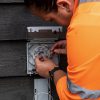Change Ensures New Build Homes are Ready for High-Speed Broadband
From today EU member states, which for now still includes the United Kingdom, are required to adopt the new Broadband Cost Reduction Directive (2014/61/EU) that will push for all newly constructed buildings to be equipped with “high-speed” ready broadband infrastructure.
The new directive (view here), which also aims to cut the cost of deploying physical infrastructure, was officially agreed all the way back in 2014 (here). At the time it even caused the UK Home Builders Federation (HBF), whose members in England and Wales deliver around 80% of the new homes built each year, to warn that the move could “seriously damage” future construction.
Advertisement
Since then the UK Government’s Digital Economy Minister, Ed Vaizey, has been pushing local authorities to make superfast broadband connectivity a part of their planning approvals process (example) and they’ve also secured a new agreement between BT and the HBF (here and here), which aims to help deliver “fibre based” (FTTC/P/H) superfast or ultrafast connectivity into new build properties across the country (either for free or co-funded). Virgin Media recently did something similar (here) and so has GTC (here).
On top of that the UK has also been working to get the EU’s new rules implemented into national law, which must happen by 1st July 2016. However the related provisions for new build properties, which include the option to introduce a voluntary Broadband-Ready Label for buildings equipped with high-speed access, will not be fully implemented until the very end of this year.
Generally the EU defines “high-speed” broadband as an Internet connectivity service that can deliver download speeds of 30Mbps (Megabits per second) or more. The rules also include a caveat for situations where imposing such an obligation might be considered “disproportionate“, such as when building an individual house in a remote location.
Article 8 – In-building physical infrastructure
1. Member States shall ensure that all newly constructed buildings at the end-user’s location, including elements thereof under joint ownership, for which applications for building permits have been submitted after 31 December 2016, are equipped with a high-speed-ready in-building physical infrastructure, up to the network termination points. The same obligation applies in the event of major renovation works for which applications for building permits have been submitted after 31 December 2016.
2. Member States shall ensure that all newly constructed multi-dwelling buildings, for which applications for building permits have been submitted after 31 December 2016, are equipped with an access point. The same obligation applies in the event of major renovation works concerning multi-dwelling buildings for which applications for building permits have been submitted after 31 December 2016.
3. Buildings equipped in accordance with this Article shall be eligible to receive the voluntary ‘broadband-ready’ label in Member States that have chosen to introduce such a label.
4. Member States may provide for exemptions from the obligations provided for in paragraph 1 and 2 for categories of buildings, in particular single dwellings, or major renovation works in cases in which the fulfilment of those obligations is disproportionate, such as in terms of costs for individual or joint owners or in terms of type of building, such as specific categories of monuments, historic buildings, holiday homes, military buildings or other buildings used for national security purposes. Such exemptions shall be duly reasoned. The interested parties shall be given the opportunity to comment on the draft exemptions within a reasonable period. Any such exemption shall be notified to the Commission.
The issue of Brexit obviously means that these rules may technically cease to be required in two or three years’ time (this all depends upon the direction of forthcoming negotiations), although the UK has already moved to adopt related legislation and we can’t see the Government rolling back their position on this otherwise widely accepted approach.
Advertisement
Mark is a professional technology writer, IT consultant and computer engineer from Dorset (England), he also founded ISPreview in 1999 and enjoys analysing the latest telecoms and broadband developments. Find me on X (Twitter), Mastodon, Facebook, BlueSky, Threads.net and Linkedin.
« ITS Technology Group Picks a New Group Chief Operating Officer

















































Comments are closed